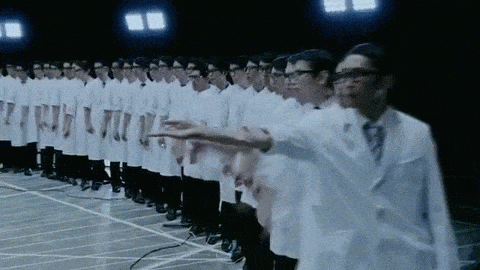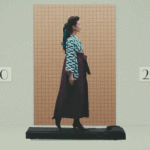This may be one of the more absurd things you see today. But who doesn’t need a little absurdity on the day after Labor Day weekend?
43 beakers lined up, each meticulously filled with water to create a musical note. Several feet away, 43 participants in lab coats. In one swift motion, all of them precisely toss a coin into the air and it lands in the in the beaker.
I’m not sure how many takes it took but the motion was captured on camera. Viewed normally it’s nothing more than an incredibly soothing 2-seconds of concentration and precision. But when slowed down, the motions reveal Mozart’s “Minuet.” (Watch the video below!)
The clever trick was pulled off by the creative agency PARTY to promote Suntory’s concentration-enhancing drink Shuchu Regain. They dubbed it the “World’s fastest coin-toss orchestra of 43 people in extreme concentration!”
Need to focus? A 2013 study by researchers at Harvard and Kyoto University found that listening to a Mozart minuet can increase focus and improve brain performance in both the young and old.


























September 15, 2015 at 12:15 pm
Looks like fodder for Captain Disillusion!
First consider the extreme difficulty of timing each toss combined with the accuracy of depth AND side to side accuracy. Through a little story-telling, we’re lead to believe that the tosses are triggered or at least signaled by electric means. If this is electric stimulation, each arm of each participant weighs a little different, so every one must be tuned, and being involuntary, would likely remove any accuracy provided by the brain. Combined across the large number of people, a single miss would mean a re-shoot, tiring out, and having to break for the day and resume the next.
Not that it’s impossible, but not an affordable commercial, and certainly would have applications for business and science outside of clever TV ads.
Now, let’s look at how it could have been done. In the first shot, the robotic camera seems to be missing from the overhead view. Maybe it’s just out of frame, but why leave this out of a documentary? Some visual storytelling is employed to encourage the viewer to infer that the tosses are a combination of electronic trigger, careful measurement and calibration, and lots of practice. Maybe…
In the side angle for the toss, there is an odd blur to the participants who don’t seem to be moving their torsos in any alarming speed to make a camera blur. Maybe this is conversion from some frame rate to that used on YouTube, I’m not an expert in this anomaly. Perhaps this a case of compositing chroma-key video to synchronize the tossers to perfection. I will wave my hand and quickly suggest that the coins in both this and the earlier shot were CG.
The robotic slow motion camera shot I suggest is real, but it’s pretense is false. the coins were delivered by an automatic system not involving human-muscle propulsion. The background of tossers is perfectly still, no arm movement or clothes rustling or these men bracing to stop their forward momentum. There should be a wave effect visible in the background just as the wave of coins falls in the foreground. These were likely mannequins dressed in lab coats. The final shot, a successful cheer, is just acting.
Still, a fascinating ad, which took a lot of work to devise, shoot, and composite, and telling a story that transcends language barrier, from a company that brought us Tommy Lee Jones turning into an Owl while day-dreaming.
September 15, 2015 at 12:18 pm
Also, the beaker that broke in the slow-mo does not break in the overhead or the side angles. Implying they succeeded twice.
September 17, 2015 at 10:00 am
The website for the drink itself is bonkers.
September 17, 2015 at 3:03 pm
@Claire – it is! I should have put a warning.